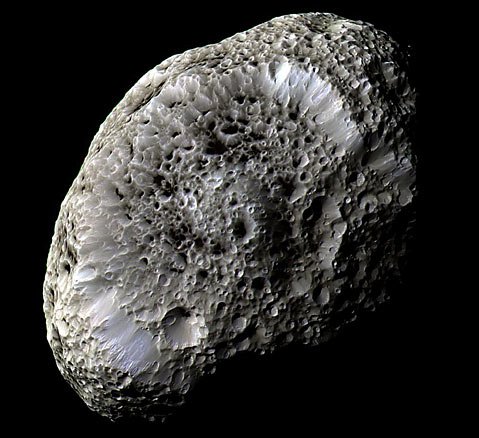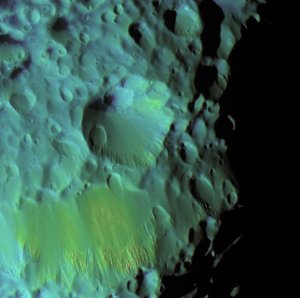Hyperion

Hyperion imaged by the Cassini spacecraft's narrow-angle camera at a distance of approx. 62,000 kilometers (38,500 miles). Credit: NASA/JPL/Space Science Institute.

The images used to create this false-color view of the crater Meri on Hyperion were acquired on 26 September 2005, at a mean distance of 17,900 kilometers (11,100 miles). Image scale is about 110 meters (360 feet) per pixel.
Hyperion is a moon of Saturn that rotates chaotically and has a bizarre sponge-like appearance. Hyperion is the largest irregular satellite in the Solar System (Neptune's Proteus is larger but almost spherical), measuring 360 × 280 × 225 kilometers. It was discovered by William and George Bond and, independently, by William Lassell, in 1848, and is also known as Saturn VII.
Like most of Saturn's moons, Hyperion has a low density, but unlike its satellite neighbors, Hyperion has a low albedo (about 0.2), indicating that it is covered by a layer of dark material. This material may have come from Phoebe having eluded Iapetus on the way. Hyperion has a reddish surface which closely matches in color the dark material on Iapetus.
Hyperion moves at a mean distance of 1.48 million kilometers from Saturn and is strongly influenced by nearby Titan. Its rotation is chaotic, its axis of rotation wobbling so much that its orientation in space is totally unpredictable. Hyperion is the only known body in the Solar System that rotates chaotically, though simulations indicate that other irregular satellites may have behaved this way in the past. Hyperion is unique in combining an irregular shape, a highly eccentric orbit, and a proximity to another large moon. These factors conspire to make rotational instability more likely. The 3:4 orbital resonance between Titan and Hyperion also appears to increase the odds of chaotic rotation. Hyperion's strange spin probably accounts for the fact that Hyperion's surface is more or less uniform, in contrast to many of Saturn's other moons which have distinctly different leading and trailing hemispheres.
Hyperion close up
New details about this oddball moon came to light in September 2005, when the Cassini spacecraft approached Hyperion to within a distance of 990 kilometers (615 miles). The surface is speckled with impact craters which have been modified by some process, not yet understood, to create a strange spongy appearance. Much of the interior of Hyperion is empty space, suggesting it is little more than a pile of space rubble. Researchers are also keen to learn the nature of dark material that seems to cover the floor of some craters.
| discovery | 1848, by William & George Bond and William Lassell |
| semimajor axis | 1,481,010 km (920,450 mi) |
| diameter | 360 × 280 × 225 km (224 × 174 × 140 mi) |
| mean density | 0.6 g/cm3 |
| escape velocity | 0.022 km/s (792 km/h, 492 mph) |
| orbital period | 21.28 days (21 d 7 h) |
| orbital eccentricity | 0.123 |
| orbital inclination | 0.43° |
| axial period | chaotic |
| visual albedo | 0.25 |


